Life Science Marketing Challenges During M&A – Relationships Among Families of Brands – Part 2
By David Chapin

SUMMARY
VOLUME 4
, NUMER 1
We continue our discussion of the marketing challenges faced during mergers and acquisitions in the life sciences. In this issue, we return to the model we recently introduced, one that provides a way to ask and answer the key question that must be addressed during mergers, acquisitions and even product or service launches: How should the relationships among different brands in a common family be portrayed to the audience? We discuss the advantages and disadvantages of the four possible answers and provide guidance for choosing one answer over the other.
Bioscience marketing during a merger or acquisition
In the last issue we outlined a useful model that depicts four ways that the relationships among different brands can be presented to the consumer. This model is strategic in nature, and it is often employed when big-picture life science marketing questions must be addressed, such as during a merger or acquisition. This model uses family relationships to describe the potential associations among brands, employing names like parent, grandparent or child to describe the positions that brands can occupy in their relationships with each other.
The key question that must be asked during a merger or acquisition is this: “How should the relationships among different brands be portrayed to the audience?” The four possible answers are depicted in Figure 1 and are summarized here:
- Parent only: This depicts an organization that promotes the parent brand alone – one that has no children.
- Parent dominant: This depicts the parent brand as more important than the children brands.
- Children dominant: This depicts the children as more important than the parent brand.
- Children with no visible parents: This depicts the children alone, with no parent brand visible.
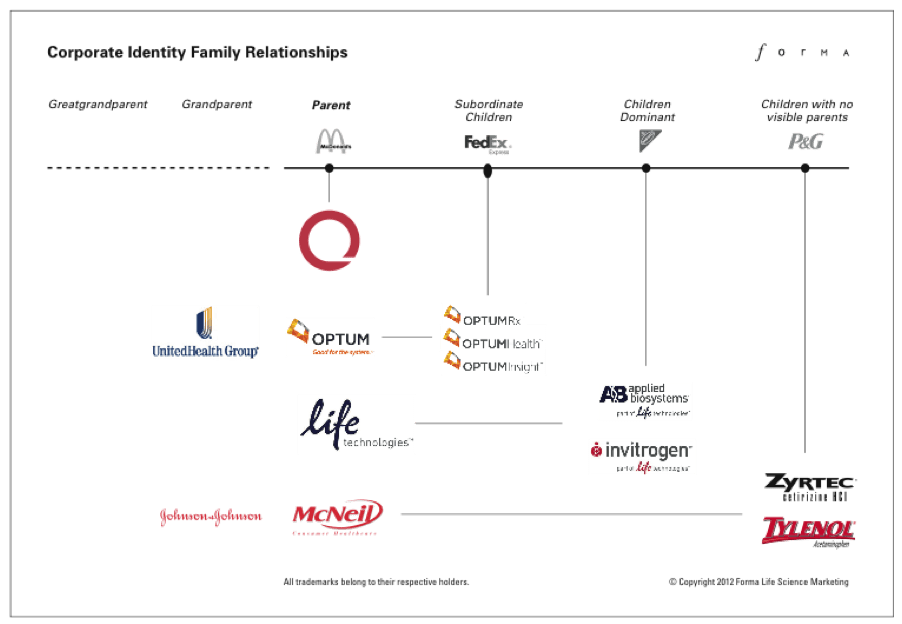
Figure 1: Shown here are four ways to answer the question: “How should the relationships among different brands be portrayed to the audience?” There are four basic answers: Parent only, Parent dominant (also referred to as Subordinate children), Children dominant and Children with no visible parents. Please note that all trademarks shown in this diagram belong to the respective trademark owners and their use in this diagram is for illustrative purposes only.
Choosing among the four possible answers to maximize your bioscience marketing effectiveness.
There are some very important reasons why marketers would choose one answer over the others when deciding how to present the relationships among two or more brands.
In addition to these factors, there are other issues that are generally applicable to all situations. I want to take the remainder of this newsletter to review these, including:
- The voice of the organization
- The complexity of the relationship among the brands
- The number of impressions of each brand the audience will see
- The overall budget efficiency of creating these impressions
- The ability to tailor the messages
- Damage control (protecting individual brand reputations)
- The ability to add products or services.
The overall voice of the organization will affect bioscience marketing during mergers and acquisitions.
Organizations that structure their brand family relationships using a Parent only model (at the left side of Figure 2) will communicate with a single voice. As organizations choose approaches that are farther to the right, more voices are added. Each voice that is added will add complexity in management for the marketing team and potential confusion for the audience.
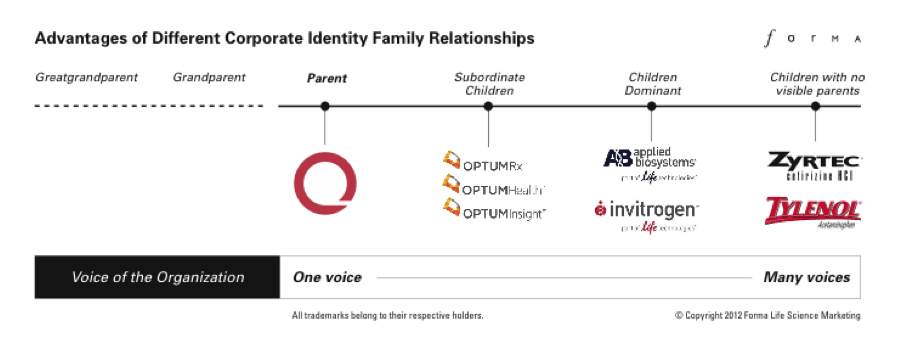
Figure 2: Your brands can share a single voice by using the Parent only approach on the left, or have many distinct voices by using the Children with no visible parents approach on the right. The examples shown in this diagram are not part of the same family – that is, we are not suggesting that Quintiles is the parent of the Optum siblings. Rather, we are showing four separate examples, one in each column: Quintiles for Parent only, Optum for Dominant Parent, etc. Please note that all trademarks shown in this diagram belong to the respective trademark owners and their use in this diagram is for illustrative purposes only.
The complexity of the presented relationship will affect bioscience marketing during mergers and acquisitions
The approach that is the simplest for the consumer to understand is that at the left end of this model: Parent only.
The approach on the right – Children with no visible parents – is simpler than the two in the middle, but it still requires that the audience understand that there are multiple brands, each with its own position and message.
Viewed from the standpoint of the complexity of the presented relationships, an approach from the left side of the model – such as Parent only – communicates most clearly with the audience.
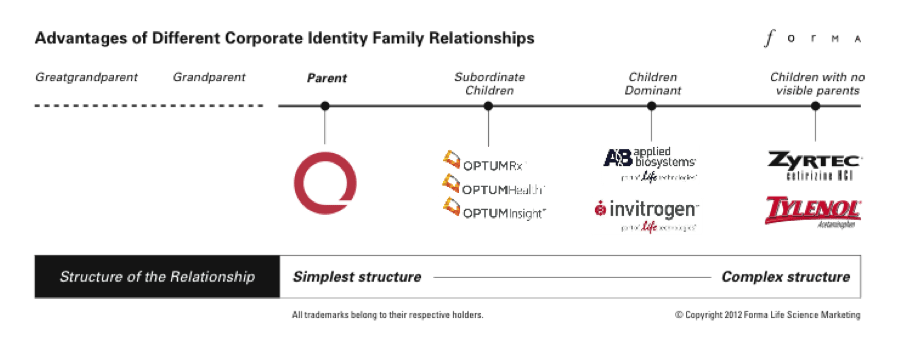
Figure 3: The structure of the presented relationship will be simplest by using the Parent only approach on the left. As you choose approaches farther to the right in this diagram, the structure of the relationships gets more complex, and requires the audience to work harder to understand the relationships involved in your family of brands. Please note that all trademarks shown in this diagram belong to the respective trademark owners and their use in this diagram is for illustrative purposes only.
The number of impressions the audience will see will affect bioscience marketing during mergers and acquisitions
The number of impressions seen by the audience is a crucial factor in determining the effectiveness of delivering a brand message or cementing a brand’s position: more impressions will be more effective.
Each of the four possible approaches depicted in Figure 4 will have very different results in this regard. In the Parent Only approach, there is only one bioscience brand, so every impression will carry the same message (assuming that the marketers are doing their job by remaining consistent and “on-target” with their message). Because there is no other message – that is, because there is no other brand being presented to the audience – the total number of impressions of this message seen by any audience member (known as message frequency) will be the highest. This increased frequency increases the ability to affect the audiences’ attitudes, beliefs and behaviors.
In the middle of the model, both the Parent dominant and Children dominant approaches, which present multiple brands to the audience, dilute the number of impressions of any one brand received by the audience. The more children there are, the more diluted the parent’s message will be. The less emphasis given to the parent (that is, the farther to the right on this model), the more diluted the parent’s message will be.
If we look at the Children with no visible parents approach, no impressions received by the audience will carry the parent’s message; all will carry one of the messages of the various children. Given a constant total budget, the more children there are, the fewer impressions each child will receive. So this approach dilutes the overall message by decreasing the number of impressions carrying each child’s message.
Viewed from the standpoint of the number of consistent impressions, an approach from the left side of the model – such as Parent only – will maximize your life science marketing impact.
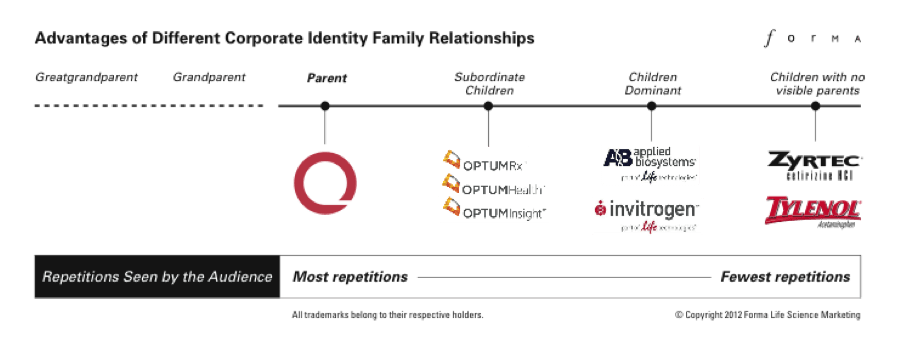
Figure 4: For a given marketing budget, audiences will be shown the most repetitions of any message by using the Parent only approach on the left. For a given budget, audiences will be shown the fewest repetitions when employing the Children with no visible parents approach on the right. Please note that all trademarks shown in this diagram belong to the respective trademark owners and their use in this diagram is for illustrative purposes only.
Budget efficiency will affect bioscience marketing during mergers and acquisitions
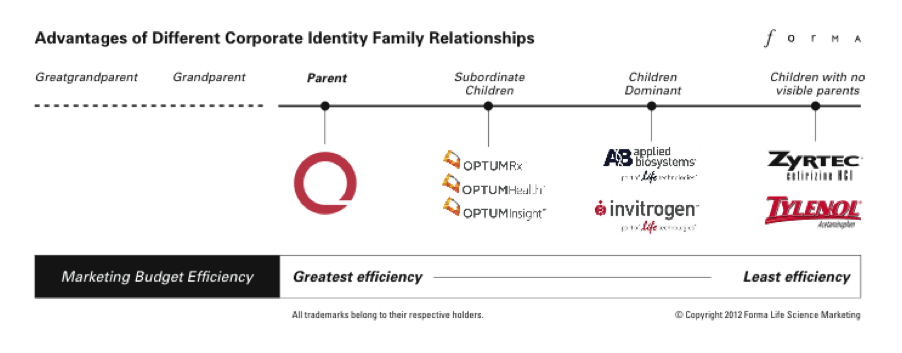
Figure 5: The efficiency of a given marketing budget will be highest when using an approach from the left of this model, such as Parent only. When choosing an approach from the right, such as Children with no visible parents, each brand must have its own marketing budget. Please note that all trademarks shown in this diagram belong to the respective trademark owners and their use in this diagram is for illustrative purposes only.
Viewed from the standpoint of budget efficiency, an approach from the left side of the model – such as Parent only – is best. Given that the three factors just discussed – the number of repetitions, the complexity of the relationship and budget efficiency – urge us to choose an approach from the left side of the model, why then would you choose an approach from the right of the model? The answers are simple yet compelling.
The ability to tailor messages will affect bioscience marketing during mergers and acquisitions
The approaches on the right of this model – such as Children with no visible parents – has an overwhelming advantage. It is easiest to deliver a tailored message to multiple audiences using this approach. Zyrtec and Tylenol are two “children” of McNeil Consumer Healthcare (see figure 1). By using two brands, McNeil has the freedom to communicate relief from allergy symptoms (Zyrtec) in a different way than it communicates relief from headache pain (Tylenol). The ability to tailor the exact type of relief being offered is important, and is one of the strongest reasons to keep “children” brands distinct from “parent” brands.
But this is not the only reason; there are several other reasons to separate the messages of “parent” brands from those of the “children.”
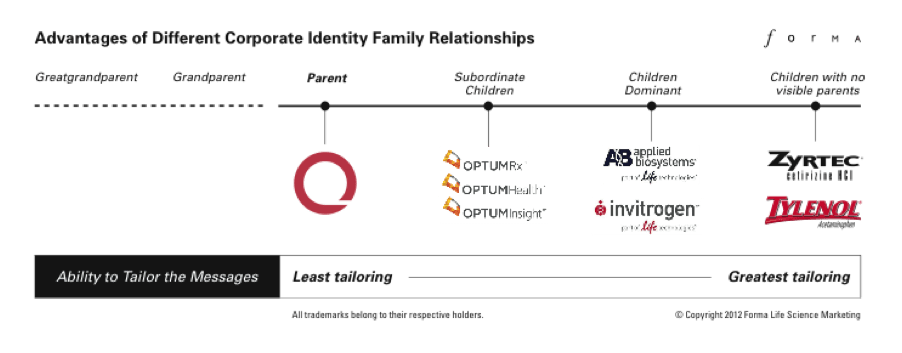
Figure 6: The ability to tailor messages to individual audiences will be highest when using an approach from the right of this model, such as Children with no visible parents. The ability to tailor messages will be least when choosing an approach that lumps all brands together under a single Parent only approach. Please note that all trademarks shown in this diagram belong to the respective trademark owners and their use in this diagram is for illustrative purposes only.
Damage control affects bioscience marketing during mergers and acquisitions
When children brands are distinct from their parents, damage control is easier. By this I mean that a scandal that affects one child brand may be kept isolated from another child brand, or even from the parent brand. The classic example is the Tylenol poisioning scandal (1982). In this case there was minimal damage to the other brands owned by McNeil and Johnson and Johnson, even though the damage to Tylenol sales was substantial – including a temporary drop in market share from 37% to 7%.
Other McNeil brands did not suffer much from this drop in market share. The difference is mainly attributable to the relationships (or lack thereof) among the brands. By following a Children with no visible parents approach, McNeil prevented trouble in one brand from contaminating another.
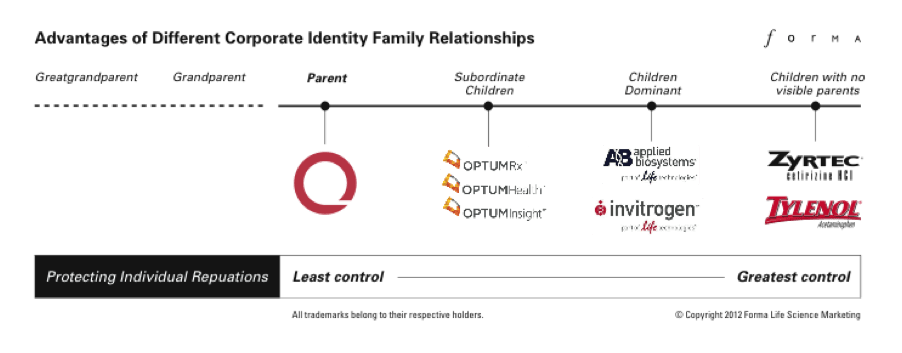
Figure 7: The ability to protect individual brands from reputational damage caused by other brands in the family will be highest when using an approach from the right of this model, such as Children with no visible parents. When approaches from the left of this model are used, damage to one brand’s reputation can more easily hurt other brands. Please note that all trademarks shown in this diagram belong to the respective trademark owners and their use in this diagram is for illustrative purposes only.
The ability to divest (or acquire) assets affects bioscience marketing during mergers and acquisitions
Brands have value, above and beyond the physical assets or the products and services that they represent. This “brand equity” can be significant. With separate brands, following the approaches on the right side of the model, this brand equity can be kept distinct from other brands. This distinction means that it is possible to divest or acquire an asset without the entanglement of trying to rebrand.
When messages are tailored and the relationship to a parent is downplayed, life science marketing assets can be more easily divested. This not only applies to brands themselves, but to products and services as well.
On the other hand, if a life science organization follows the approach from the left side of this model – that of Parent only – then individual services are not branded. Therefore, services can be added (or removed) from the overall mix of services at will, without having to devote life science marketing resources to creating and promoting a new brand.
So, approaches from either end of the model allow greater freedom in adding or divesting products and services. But when the Children with no visible parents approach is used, marketing resources must be dedicated to the children. The amount of marketing resources that must be devoted to creating and promoting a new service will rise the farther to the right an organization moves on this diagram. At the far right, a new service would require its own brand, marketed separately from the rest of the organization’s brands.
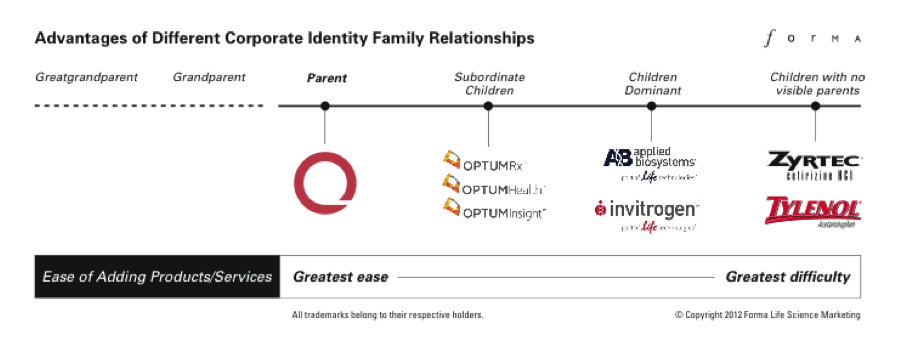
Figure 8: The ability to add (or delete) products and services is easiest to manage at the left end of this diagram. When each individual product or service requires its own separate brand (when using an approach like Children with no visible parents), additional marketing management and attention is required. Please note that all trademarks shown in this diagram belong to the respective trademark owners and their use in this diagram is for illustrative purposes only.
Conclusion:
There are many reasons to choose one approach over another when deciding how to present the relationships among a family of brands in the life sciences. These criteria do not uniformly favor one approach over all the others; there are good reasons to choose each individual approach I have outlined. Some of the criteria to consider when making your choice include:
- The voice of the organization – a single voice or multiple voices.
- The complexity of the relationship among the brands.
- The number of impressions of each brand the audience will see.
- The overall budget efficiency of creating these impressions.
- The ability to tailor the messages for each brand.
- Damage control (protecting individual brand reputations).
- The ability to add products or services.
In our next issue we will look at several sectors in the life sciences and show that among specific sectors, there is often a common approach. We’ll examine the reasons for this.
Summary
- The fundamental question for life science marketers during mergers and acquisitions is: What happens to the life science marketing assets (the positioning, the messages, the taglines, the names, the identities and the “look and feel”) of the two organizations?
- There are four typical answers to this question.
- A parent-only model, where only one entity survives
- A parent-dominant model, where the parent can have many children, but the parent is the dominant marketing entity.
- A child-dominant model, where the many children are presented as more important than the parent.
- A children only model, where the parent is not presented.
- Many factors will influence the answer of which life science marketing relationship should be chosen. Factors that are specific to each individual situation include: the audience, the current “brand equity”, the strategic direction of the two entities, the positioning of the two entities, the size of the two entities, the amount of competition between the two entities and the overall marketing budget are all important when choosing a marketing strategy.
- There are other factors that are generally applicable to all situations, including:
- The voice of the organization
- The complexity of the relationship among the brands
- The number of impressions of each brand the audience will see
- The overall budget efficiency of creating these impressions
- The ability to tailor the messages
- Damage control (protecting individual brand reputations)
- The ability to add products or services.
- Choosing the proper approach for any individual situation requires an astute balance among the various issues raised by these different factors.
The Marketing of Science is published by Forma Life Science Marketing approximately ten times per year. To subscribe to this free publication, email us at info@formalifesciencemarketing.com.
David Chapin is author of the book “The Marketing of Science: Making the Complex Compelling,” available now from Rockbench Press and on Amazon. He was named Best Consultant in the inaugural 2013 BDO Triangle Life Science Awards. David serves on the board of NCBio.
David has a Bachelor’s degree in Physics from Swarthmore College and a Master’s degree in Design from NC State University. He is the named inventor on more than forty patents in the US and abroad. His work has been recognized by AIGA, and featured in publications such as the Harvard Business Review, ID magazine, Print magazine, Design News magazine and Medical Marketing and Media. David has authored articles published by Life Science Leader, Impact, and PharmaExec magazines and MedAd News. He has taught at the Kenan-Flagler Business School at UNC-Chapel Hill and at the College of Design at NC State University. He has lectured and presented to numerous groups about various topics in marketing.
Forma Life Science Marketing is a leading marketing firm for life science, companies. Forma works with life science organizations to increase marketing effectiveness and drive revenue, differentiate organizations, focus their messages and align their employee teams. Forma distills and communicates complex messages into compelling communications; we make the complex compelling.
© 2024 Forma Life Science Marketing, Inc. All rights reserved. No part of this document may be reproduced or transmitted without obtaining written permission from Forma Life Science Marketing.
